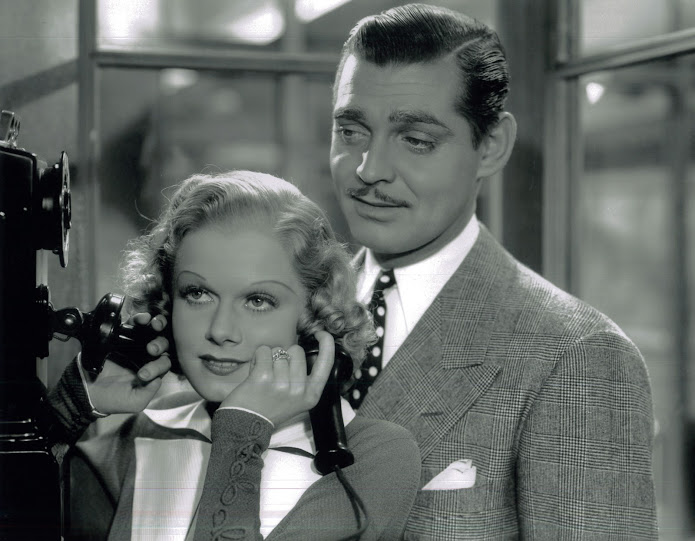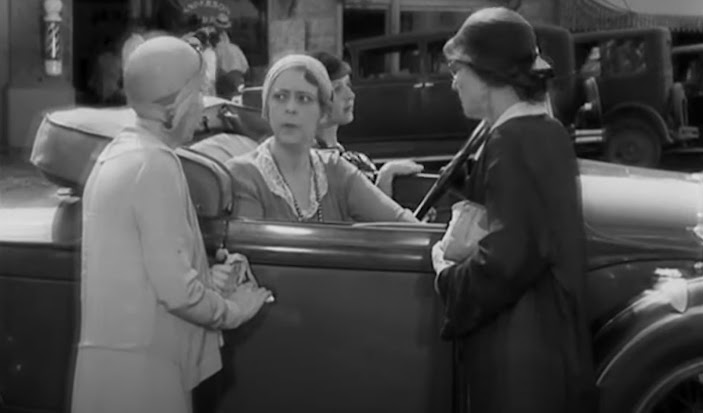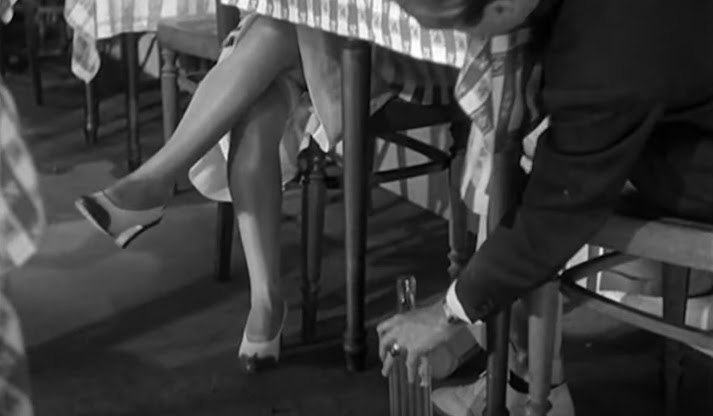Clay Molded Into Metro Special
How to Tell a Story That Became Wife vs. Secretary (1936)
Retrieved via research done at USC’s Cinema Library in 1989 are memos generated by Metro in 1934-35 for project that became Wife vs. Secretary, released in early 1936 as vehicle for star trio Clark Gable, Jean Harlow, and Myrna Loy, and directed by Clarence Brown. A story editor by name of Ray Long declares (10/18/34), “This is to be the exceptional, the totally different story of a triangle. Instead of being played with rancor or peevishness, it is to be played light-heartedly and in a tempo like that of The Thin Man.” What was it to be an “exceptional” or “totally different” property at MGM circa 1934? Did narrative often begin this way before varied hands applied sameness and convention? 10/18/34 was but months into stricter Code enforcement. Surely there were ideas submitted for Wife vs. Secretary that ultimately got dropped. Overlap with style and humor of The Thin Man lets us know how influential that historic hit was, not only in terms of audience popularity, but ways it was imitated for seasons to come. Fresh styles of humor were not long fresh once seized by others and bled white, The Thin Man and It Happened One Night (also 1934) two most copied concepts from whole of the thirties. Wife vs. Secretary was intended for William Powell to headline. As “Vanning Sanford,” Powell “loves parties, likes his cocktails and highballs.” Alcohol consumption had become a screen signature for this star, The Thin Man best evidence of glamour associated with drink, now safely legalized in the US and adding patina of sophistication to modern-set romances and comedy. Powell as ambassador for such lifestyle would peak however with The Thin Man, Code policy forbidding excess of liquor consumption lest it be aped by audiences.
 |
| Image Restoration Courtesy Mark Vieira/ Starlight Studio |
Wife vs. Secretary was for complicating the lives of otherwise enviable characters so that patrons could exit relieved and refreshed: “It should send husbands, wives, and secretaries out of the theater, each saying, “Well, at least we get a break.”” This was old psychology, the rich and beautiful beset with problems that wealth or attractiveness alone, or combined, cannot overcome. In the end, a Gable or Harlow must conform to standards we all observe, lest bear disgrace for their trespass. If we cannot be these characters, or live in any way like them, then let us feel superior to folly that leads identification figures to near-ruin. Even Clark Gable has nothing on us for plain common sense. Dynamic operations were the stuff of thirties romance emerging but slow from Depression’s grip. Wife vs. Secretary is set amidst high-powered publishing, model being the Curtis Company in Philadelphia, its entire operation under one roof. Curtis wasn’t indicated by name, but insiders recognized the brand, this being where slick magazines and advertising to buttress them saw birth. Imagine those inspired by such example choosing occupation along sped-up line that was slicks plus promoting that went with them. Salaries allowed for elegant homes, nightly revel, and servants at ready. This was private enterprise equivalent to stage celebrity or other such noteworthy enterprise, exotic as to be out of reach but not altogether inaccessible. Harlow’s secretary character will cede marriage or family just to work among trend-setters despite mere clerical status. “I think I shall die an old maid. I’m going to stick by Bill (Powell) at the office … I need my life with him more that I need any husband,” hers or any ambitious woman's philosophy as MGM story staff understood it.
 |
| Clarence Brown Directs Clark Gable and Myrna Loy |
The Code obliged filmmakers to adopt an unreal posture. How could a Jean Harlow accept spinsterhood and lifelong platonic association with a William Powell, let alone Clark Gable as Powell’s casting substitute? Audiences would be asked by the mid-thirties to suspend disbelief aroused by situations that were frankly implausible. Said producer Hunt Stromberg upon assignment to Wife vs. Secretary: “Vanning Sanford (Gable’s character, later changed to Van Stanhope) is deeply attached to and fond of the girl (Harlow) because she, in some measure, is like a nurse who has faithfully and unselfishly administered to a person through illness. These sorts of people cannot help but be loved. And when we say loved in this instance, we do not associate it with the physical nor the passionate.” It was as though Stromberg was trying to kid himself and others through idealized personalities not the least like all-too-human nature of those making Wife vs. Secretary and others who'd eventually watch it. Stromberg burrows deep for conviction that such people might actually exist in some corner of real life: “You can love a person to the extent of doing anything for them --- or risking anything. That does not mean that you would kick your wife in the face and go to bed with the girl.” In less circuitous terms, Stromberg was telling all who’d listen to do as we say, not as we do, “we” being MGM higher-ups and godlike stars long in the habit of taking what they wanted and never mind morality or consequence. Wife vs. Secretary as much as any post-Code represented fork in roads headed for untruth many movies had to cope with until clever enough personnel devised ways to tell an adult story more adroitly.
Stromberg wanted spice of The Thin Man but knew he’d not have that under guidelines recently imposed. “All this opening (breakfast scene) should be a veritable whirlwind of pace and bright, amusing business, in which we warm up to these people instantly in something of the vein of The Thin Man relationship.” Wife vs. Secretary does less effectively what The Thin Man had done so right. Clark Gable has not the urbanity of Powell. He seems to struggle with an unfamiliar setting, and over-cute dialogue won’t help. And whose idea was it to have him gift Myrna Loy with a bracelet wrapped inside a fried flounder? Messy to say the least, as who would want the fish after jewelry is pried out? The Sanford lifestyle is lavish, but Van’s is a common touch. He even bets with a servant on the outcome of a sporting event. Their marriage is a perfect one, but the Stanhopes do not share a bedroom, Van coyly asking how “Linda” got along “after that man (himself) left last night,” assuring us that he at least enjoys conjugal access to her separate sleeping quarter. The stage is set for a threat to this union, but it won’t come from steadfast secretary Harlow as “Whitey Wilson,” interestingly named as this was when MGM browned Harlow’s platinum hair to normalize her appearance and persona. Whitey lives with parents and has a drip of a boyfriend (James Stewart) who wants her to chuck the job and marry him. Any life at the office, even a chaste one, would be preferable to this. At no time is attraction indicated between Van and Whitey, an unnatural state as between Gable and Harlow, who had coupled so readily but a few years prior.
Hunt Stromberg saw nonsensical aspect of the pairing. How could this secretary “admire” her boss without “wanting to climb in the hay with him,” a concern to mirror that of audiences to come. Had 1936’s public entered willing compact with Hollywood to make a best of unwanted circumstance, to give up goodies all knew could not last? Cries for censorship had been long and persistent, it obvious that truce of sorts must be reached if movies were to last. Stromberg declared that Wife vs. Secretary would “break the chain of MGM’s women’s formula,” which he could argue it did, but to whose loss? Source story was from pages of Cosmopolitan, Faith Baldwin the author, and we’ll assume she spun the yarn more honestly than screenwriters Norman Krasna, Alice Duer Miller, and John Lee Mahin managed. Essential problem lay in fact that if Harlow/Whitey could not have Gable/Van, what then would be her outcome? Question was asked and answered by 4/26/35, Harlow alone at the end, but not, Stromberg assured, “a long-suffering Cinderella, who sits by and tears out her heart while the wife eats all the frosting from the cake.” Did Wife vs. Secretary achieve satisfying resolution? Not from perspective of eighty-seven passed years, logic telling us, as it surely did viewers in 1936, that Whitey must leave her job and accept consolation prize that is simpering Stewart, him of seventy-five a week job he’ll expect both to live on, Van and his staff-full apartment a gone dream. Assurance Whitey has done the “right” thing by giving up Gable left, still leaves, ashen aftertaste.
 |
| Could Gable Play a Character of Great Intellect and Achievement? Your call! |
 |
| Harlow and Whiny Consolation Prize She Gets |
Casting concerns are reflected in the memos. Insiders surprisingly made same assumptions re limitation of MGM stars that a public or unsympathetic critics might have. Stromberg expressed doubt that Clark Gable could play “a man of great mental brilliance and of intellectual background … a character that represents another type of world entirely.” These were not issues with William Powell initially aboard. Did Stromberg adopt too narrow a view of Gable? “In my opinion, Gable … is too much the type of brawn and muscle, as all his great performances have proven.” This actor could not show Van Stanhope’s “polish – association with big enterprises --- great, keen wit, and intellect --- charm of personality --- gentleness --- but above all, achievement.” A tall order for any player, especially one defined in terms of “personality.” Had Gable or any of Metro talent an idea of how coolly they were appraised by handlers, often thought inadequate by estimation of higher-ups? As to job of being Van Stanhope, “I’m not sure at all whether Gable could accomplish this,” said Stromberg. Despite immense popularity, Gable like anyone had to prove his ability, range if needed within a defined persona, again and again. Consider challenge of Mutiny on the Bounty to be met, a part Gable was certain he could not handle. Studio support could go but so far. In the end, all players had to fend for themselves. Debacle that was Parnell would demonstrate limit even to competence and ingenuity otherwise taken for granted within the factory system. No star for a moment could assume they were entirely safe.
 |
| Mother Knows Best, Says May Robson to Myrna Loy |
Wife vs. Secretary would be about the suspicion of adultery rather than adultery itself, or “something smutty” in Gable/Van parlance. This is a man who had rolled with married Mary Astor but four years before in Red Dust. Whispers start among the Stanhope’s mean-spirited friends. For damage done, we wish the couple could find new friends. Stanhope parties are filled with Iagos. Temptation is but momentarily addressed, and that well into Act Three. Harlow’s sexuality was sacrificed to the new order along with her hair color. Gable’s too, him much the goofball here, “a sexual Mister Magoo” as writer Rene Jordan observed. Beacon of sense turns out to be May Robson as Van’s mother, who explains secretarial threat to oblivious Myrna Loy. One thing the Code did not do was place muzzles on mothers. They could voice reality movies were otherwise forbidden to explore, like for instance a husband’s always-inclination to cheat, as in “leaving a small boy alone in a room with a box-full of candy.” Of course he’s going to eat it, be sorry later, but still … he will eat. Movie moms accepted facts of married life and tried passing wisdom to daughters. Remember The Women where Lucile Watson tells Norma Shearer that her father once (heck, several times) had affairs? … after which marriage sustained because after all “he never loved those women.” Stick it out, Mother counsels. Never leave on a point of pride. Maybe wives were better off, she says, when divorce was not an option, and they had to stay, whatever the husband’s improprieties. Imagine Robson/Watson monologues delivered today. There would be much talent in breadlines after.
Wife vs. Secretary triumphs on gloss enough to work a sort of mass-hypnotism upon watchers. I pondered upon lives of its cast --- what they were thinking, as in who among them attached any more value to this piece than the throwaway Cosmopolitan tale it was based upon. One reason stars got restless was ephemeral nature of work they did. Were I to somehow re-call shades of Gable, Harlow, and Loy to tell them how much I enjoyed Wife vs. Secretary in 2023, they’d rightly tab me cracked. Too little is known of what drove these folks, how they regarded their work, because (1) Gable talked hardly ever of past jobs and died too soon (1960) for serious profiling, not that he necessarily would cooperate, (2) Harlow was gone a year and a half (1937) after being Whitey, leaving only Loy, and to lesser degree James Stewart, to sort out what went on so many years before. Loy made up to some degree for loss of the others, being a perceptive, and I think reliable, surviving witness to 30’s MGM she was among last to describe. Loy speaks yet on You Tube chats varied as Dick Cavett guesting or phone conversation her caller recorded no doubt without consent (one wherein she takes off on Katharine Hepburn, whom she disliked and thought a “show-off”). All are ghosts now, us left with ghostly videos. Interview programs were not done to last. Film and stills taken to promote film do however have a permanency, assuming they are properly preserved. Images posted here and elsewhere boast clarity a tribute to what artists achieved in 1935-36, Wife vs. Secretary reborn thanks to Warner Archives’ newly released Blu-Ray. Classic era artifacts have come a long way from thirty-forty or more years ago when remnants looked as if they’d not again see freshness of the new. Ironic that now with all of principals from the era gone, we finally have Wife vs. Secretary and others like it to enjoy as they should have been from respective starts.


















































